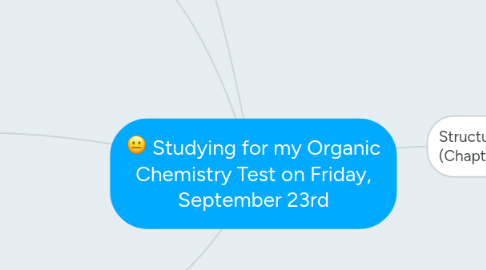
1. Alkane Nomenclature and Conformation (Chapter 2
1.1. Alkane Roots
1.1.1. Know the names of alkanes with 1-10 carbons and name substituents with 1-10 carbons using IUPAC rules
1.2. Carbon Subsititution
1.2.1. Be able to assign carbons as primary, secondary, tertiary, or quartenary
1.3. Alkane Nomenclature
1.3.1. Provide IUPAC systematic names for alkanes, draw correct structures when given an IUPAC name, and use formal IUPAC names when applicable
1.4. Cycloalkanes
1.4.1. Name cycloalkanes as the parent hydrocarbon
1.5. Newman Projections
1.5.1. Draw staggered and eclipses Newman projections for a given molecule
1.6. Conformer Stability
1.6.1. Know energy costs for eclipsed and gauche, and be able to predict the relative stability of different alkane conformations based on these interactions
2. Functional Groups and IR Spectroscopy (Chapter 3)
2.1. Functional Groups
2.1.1. Recognize common functional groups and formally name molecules with functional groups
2.2. IR Spectral Analysis
2.2.1. Identify functional groups from an IR-spectrum by labeling the exact peak positions associated with vibrational modes
2.3. Organic Structure Determination
2.3.1. Identify functional groups for a compound given a chemical formula and IR spectra and be able to identify an unknown structure given a list of possible compounds with different functional groups.
3. General Test Information
3.1. Sample exams on the class website
3.2. Practice sets, in-class assignments, Sapling, and book questions are good ways to study
4. Practice Examinations
4.1. Old exam posted to identify with they type of questions that will be asked
5. Structure and Molecular Orbitals (Chapter 1)
5.1. Molecular Orbital Theory
5.1.1. Know what orbitals are used to make different types of bonds
5.2. Hybridization
5.2.1. Predict the hybridization of an atom based on a given structure and geometry
5.3. Drawing Organic Compounds
5.3.1. Interpret skeletal drawings and correctly draw organic compounds
5.4. Formal Charges
5.4.1. Predict formal charges when drawing structures
5.5. Resonance Structures
5.5.1. Draw resonance structure, understand resonance hybrid, and predict relative stability
